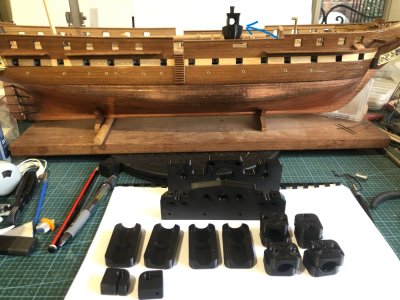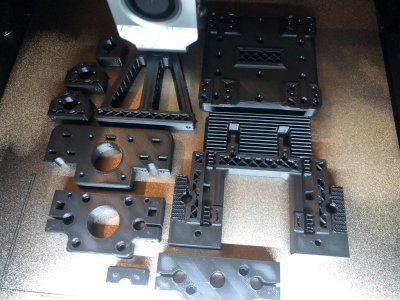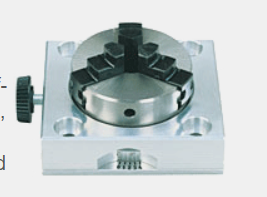Seems that the MF70 is perfect for this, just small parts, but it seems to work. Please show us.
will do.
I purchased the stepper motors and the mounting hardware, along with the controller from ebay. I don't think they sell them anymore but I think you can still get the mounting hardware. The stepper motors are Nema 17 so those should be easy to find. For the controller card I decided I am going to use the one that is used by my cnc engraver because I want to use GRBL and the card that is with this kit has ESTLCAM firmware that I am not familiar with. I think you can change the firmware, but it's an older card and I want something modern.
So, once I have assembled the hardware and installed the stepper motors, then I have to change the GRBL configuration. I could use some help with what some of the addresses are for. In particular 100 to 122.
100, 101, and 102 are calculations that I need to research.
I am unclear on what settings to use for 110 to 122
Grbl 1.1f [‘$’ for help]
>>> $$
$0 = 10 (Step pulse time, microseconds)
$1 = 25 (Step idle delay, milliseconds)
$2 = 0 (Step pulse invert, mask)
$3 = 5 (Step direction invert, mask)
$4 = 0 (Invert step enable pin, boolean)
$5 = 0 (Invert limit pins, boolean)
$6 = 0 (Invert probe pin, boolean)
$10 = 3 (Status report options, mask)
$11 = 0.010 (Junction deviation, millimeters)
$12 = 0.002 (Arc tolerance, millimeters)
$13 = 0 (Report in inches, boolean)
$20 = 0 (Soft limits enable, boolean)
$21 = 0 (Hard limits enable, boolean)
$22 = 0 (Homing cycle enable, boolean)
$23 = 0 (Homing direction invert, mask)
$24 = 25.000 (Homing locate feed rate, mm/min)
$25 = 500.000 (Homing search seek rate, mm/min)
$26 = 250 (Homing switch debounce delay, milliseconds)
$27 = 1.000 (Homing switch pull-off distance, millimeters)
$30 = 1000 (Maximum spindle speed, RPM)
$31 = 5 (Minimum spindle speed, RPM)
$32 = 0 (Laser-mode enable, boolean)
$100 = 800.000 (X-axis travel resolution, step/mm)
$101 = 800.000 (Y-axis travel resolution, step/mm)
$102 = 800.000 (Z-axis travel resolution, step/mm)
$110 = 2500.000 (X-axis maximum rate, mm/min)
$111 = 2000.000 (Y-axis maximum rate, mm/min)
$112 = 1500.000 (Z-axis maximum rate, mm/min)
$120 = 45.000 (X-axis acceleration, mm/sec^2)
$121 = 45.000 (Y-axis acceleration, mm/sec^2)
$122 = 48.000 (Z-axis acceleration, mm/sec^2)
$130 = 300.000 (X-axis maximum travel, millimeters)
$131 = 180.000 (Y-axis maximum travel, millimeters)
$132 = 44.000 (Z-axis maximum travel, millimeters)













